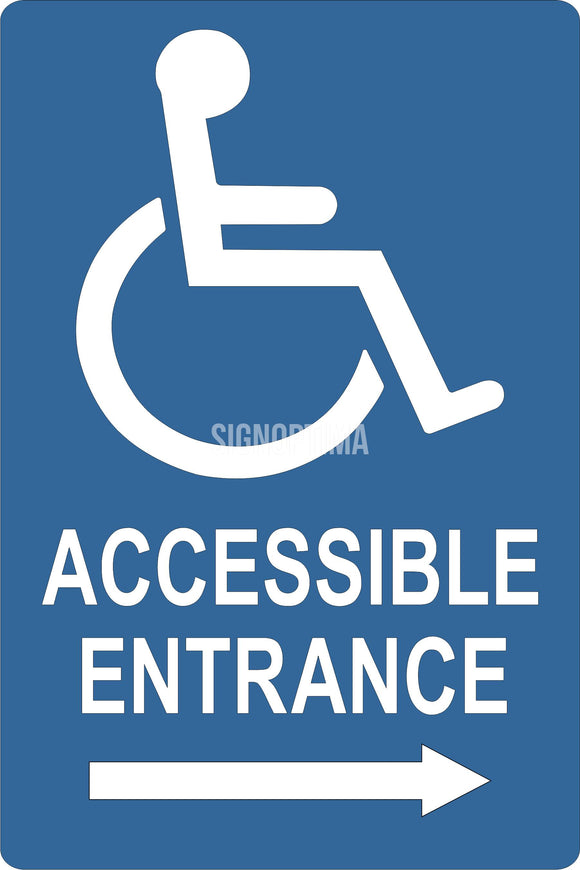The Impact of ADA Signs on Community Accessibility
The Impact of ADA Signs on Community Accessibility
Blog Article
Checking Out the Key Features of ADA Indications for Enhanced Access
In the realm of access, ADA indications function as silent yet powerful allies, making certain that spaces are navigable and inclusive for individuals with disabilities. By integrating Braille and responsive aspects, these signs damage barriers for the aesthetically impaired, while high-contrast shade systems and understandable fonts cater to diverse visual requirements. Furthermore, their critical positioning is not arbitrary but instead a computed initiative to help with smooth navigation. Past these attributes exists a deeper story concerning the development of inclusivity and the ongoing dedication to producing equitable rooms. What more could these indicators represent in our pursuit of universal availability?
Value of ADA Conformity
Guaranteeing compliance with the Americans with Disabilities Act (ADA) is critical for promoting inclusivity and equivalent access in public rooms and offices. The ADA, passed in 1990, mandates that all public facilities, employers, and transportation solutions accommodate people with specials needs, ensuring they appreciate the exact same civil liberties and chances as others. Conformity with ADA standards not only meets legal obligations yet also boosts an organization's track record by showing its dedication to diversity and inclusivity.
One of the vital facets of ADA conformity is the execution of easily accessible signage. ADA signs are designed to ensure that people with handicaps can easily navigate with buildings and rooms.
Additionally, sticking to ADA regulations can mitigate the danger of legal repercussions and potential fines. Organizations that fail to adhere to ADA standards might deal with claims or penalties, which can be both financially difficult and damaging to their public picture. Hence, ADA compliance is indispensable to promoting an equitable environment for everybody.
Braille and Tactile Components
The consolidation of Braille and tactile aspects into ADA signs symbolizes the concepts of ease of access and inclusivity. These attributes are essential for individuals that are blind or aesthetically impaired, allowing them to navigate public areas with better independence and self-confidence. Braille, a tactile writing system, is crucial in offering created information in a format that can be easily regarded with touch. It is usually put beneath the corresponding message on signs to make certain that individuals can access the info without aesthetic aid.
Tactile elements extend past Braille and consist of increased personalities and signs. These components are designed to be discernible by touch, permitting people to recognize space numbers, bathrooms, leaves, and various other vital areas. The ADA sets certain standards pertaining to the dimension, spacing, and placement of these responsive elements to maximize readability and make certain consistency across various environments.

High-Contrast Color Design
High-contrast color design play a crucial function in enhancing the presence and readability of ADA signs for people with visual problems. These schemes are important as they optimize the distinction in light reflectance between message and history, making sure that signs are quickly discernible, also from a distance. The Americans with Disabilities Act (ADA) mandates making use of certain color contrasts to fit those with restricted vision, making it an important aspect of compliance.
The efficiency of high-contrast shades lies in their capability to stand out in different lighting problems, consisting of poorly lit atmospheres and locations with glow. Normally, dark text on a light history or light message on a dark background is utilized to attain optimal comparison. Black message on a white or yellow background supplies a raw visual difference that helps in fast recognition and understanding.

Legible Fonts and Text Size
When considering the layout of ADA signs, the option of readable font styles and suitable text size can not be overemphasized. The Americans with Disabilities Act (ADA) mandates that fonts should be sans-serif and not italic, oblique, manuscript, very ornamental, or of unusual kind.
The dimension of the message likewise plays an essential role in ease of access. According to ADA guidelines, the minimal message height should be 5/8 inch, and it should raise proportionally with seeing distance. This is specifically crucial in public areas where signage needs to be reviewed you could try these out quickly and accurately. Uniformity in text dimension adds to a cohesive aesthetic experience, helping people in navigating atmospheres efficiently.
Furthermore, spacing in between letters and lines is indispensable to clarity. Ample spacing avoids personalities from appearing crowded, boosting readability. By adhering to these requirements, i thought about this developers can dramatically enhance accessibility, ensuring that signs offers its desired function for all people, despite their visual capacities.
Reliable Placement Approaches
Strategic placement of ADA signs is important for making the most of availability and guaranteeing conformity with lawful standards. Appropriately located signs direct people with handicaps effectively, assisting in navigating in public rooms. Trick considerations include presence, elevation, and closeness. ADA guidelines specify that indicators need to be mounted at a height in between 48 to 60 inches from the ground to guarantee they are within the line of sight for both standing and seated people. This basic height range is important for inclusivity, enabling mobility device individuals and individuals of varying elevations to access information effortlessly.
Additionally, indications must be placed beside the lock side of doors to enable easy recognition prior to access. This placement helps people find rooms and spaces without blockage. In situations where there is no door, indications ought to be situated on the local nearby wall surface. Consistency in indication placement throughout a center improves predictability, decreasing confusion and boosting general user experience.

Verdict
ADA indications play an essential role in advertising accessibility by incorporating functions that attend to the requirements of people with disabilities. Integrating Braille and responsive aspects ensures crucial details comes to the visually damaged, while high-contrast color pattern and clear sans-serif typefaces boost visibility throughout various lighting conditions. Effective positioning strategies, such as ideal mounting elevations and critical areas, better promote navigation. These elements jointly cultivate an inclusive environment, underscoring the importance of ADA conformity in making certain equivalent access for all.
In the realm of availability, ADA signs offer as quiet yet powerful allies, making sure that rooms are comprehensive and navigable for individuals with handicaps. The ADA, enacted in 1990, mandates that all public facilities, employers, and transport solutions suit people with impairments, ensuring they take pleasure in the exact same civil liberties and opportunities as others. ADA Signs. ADA signs are designed to guarantee that individuals with impairments can quickly browse with structures and spaces. ADA guidelines specify that signs ought to be placed at an elevation between 48 to 60 inches from the ground to guarantee they are within the line of view for both standing and seated people.ADA signs play an essential role in advertising ease of access by integrating attributes that attend to the requirements of people with impairments
Report this page